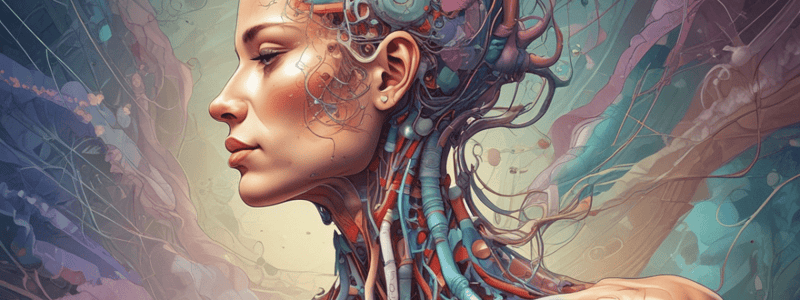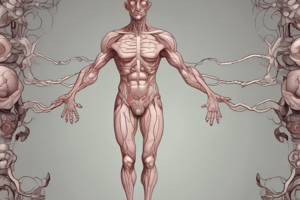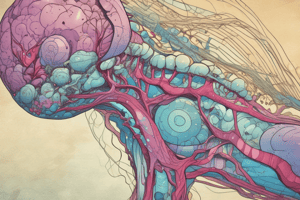Podcast
Questions and Answers
What is the primary function of CRH in the hypothalamus?
What is the primary function of CRH in the hypothalamus?
- Regulation of thyroid hormone release
- Regulation of growth hormone release
- Inhibition of prolactin release
- Stimulation of adrenal glands (correct)
Which of the following hormones is NOT produced by the anterior pituitary?
Which of the following hormones is NOT produced by the anterior pituitary?
- TRH (correct)
- PRL
- ACTH
- TSH
What is the effect of somatostatin on growth hormone secretion?
What is the effect of somatostatin on growth hormone secretion?
- Stimulation of growth hormone release
- Regulation of thyroid hormone release
- Stimulation of prolactin release
- Inhibition of growth hormone release (correct)
What is the primary function of GH in adults?
What is the primary function of GH in adults?
What is the result of growth hormone deficiency in childhood?
What is the result of growth hormone deficiency in childhood?
What is the effect of IGFs on lipid metabolism?
What is the effect of IGFs on lipid metabolism?
What is the function of GHRH in the hypothalamus?
What is the function of GHRH in the hypothalamus?
What is the effect of GH on bone growth?
What is the effect of GH on bone growth?
What is the mechanism of GH action on cells?
What is the mechanism of GH action on cells?
What is the function of PRH in the hypothalamus?
What is the function of PRH in the hypothalamus?
Which of the following functions is NOT performed by the hypothalamic pituitary axis?
Which of the following functions is NOT performed by the hypothalamic pituitary axis?
What is the origin of the anterior pituitary gland?
What is the origin of the anterior pituitary gland?
Which hormone is NOT produced by the hypothalamus and released by the posterior pituitary gland?
Which hormone is NOT produced by the hypothalamus and released by the posterior pituitary gland?
What is the role of the hypophyseal portal system in anterior pituitary function?
What is the role of the hypophyseal portal system in anterior pituitary function?
Which of the following is a characteristic of neurocrine function?
Which of the following is a characteristic of neurocrine function?
What is the role of the posterior pituitary gland in the regulation of water homeostasis?
What is the role of the posterior pituitary gland in the regulation of water homeostasis?
Which of the following hormones is NOT released by the anterior pituitary gland?
Which of the following hormones is NOT released by the anterior pituitary gland?
What is the relationship between the hypothalamus and the posterior pituitary gland?
What is the relationship between the hypothalamus and the posterior pituitary gland?
Flashcards are hidden until you start studying
Study Notes
Hypothalamic Pituitary Axis
- The hypothalamic and pituitary gland forms a complex functional unit that serves as the major link between the endocrine and nervous systems
- Modulates a wide variety of processes: • Body growth • Reproduction • Adrenal gland function • Water homeostasis • Milk secretion • Lactation • Thyroid gland function • Puberty
Pituitary Gland
- Consists of two parts: • Anterior pituitary gland (adenohypophysis) - endocrine tissue • Posterior pituitary gland (neurohypophysis) - nerve tissue
- The anterior and posterior pituitary glands have distinct embryological origins and distinct functions: • Anterior pituitary arises from evagination of oral ectoderm (Rathke's pouch) - primitive gut tissue • Posterior pituitary originates from neuroectoderm - primitive brain tissue
Neurocrine Function of Posterior Pituitary
- Hormones produced in the hypothalamus
- Oxytocin and antidiuretic hormone (vasopressin) produced by neurosecretory cells in the supraoptic and paraventricular nuclei of the hypothalamus
- Transported down nerve cell axons in vesicles to the posterior pituitary
- Stored and released from posterior pituitary nerve endings into the general circulation to act on distant targets
Anterior Pituitary Function
- Hormones synthesized in the hypothalamus are transported down axons and stored in the median eminence before release into the hypophyseal portal system
- These hormones stimulate (or inhibit) target endocrine cells in the anterior pituitary gland (neurocrine function)
- Endocrine cells of the anterior pituitary secrete a variety of hormones into the bloodstream to act on distant target cells (endocrine function)
Tropic Hormones of the Hypothalamus
- 6 tropic hormones (stimulating) produced in the hypothalamus: • TRH (thyrotropin-releasing hormone) • PRH (prolactin-releasing hormone) = TRH (minor +ve control on prolactin) • PIH (prolactin-release-inhibiting hormone) (dopamine) • CRH (corticotropin-releasing hormone) • GnRH (gonadotropin-releasing hormone) • GHRH (growth hormone-releasing hormone) • GHIH (growth hormone-inhibiting hormone) (Somatostatin)
Hormones Produced by the Anterior Pituitary
- TSH (thyroid-stimulating hormone)
- ACTH (adrenocorticotropic hormone)
- LH (luteinizing hormone)
- PRL (prolactin)
- GH (growth hormone)
Negative Feedback
- The pathways by which hypothalamic and anterior pituitary hormones are produced are often regulated by negative feedback: • Short loop or long loop negative feedback pathways
Growth Hormone
- Produced in the anterior pituitary: • Stimulated by hypothalamic GHRH • Inhibited by hypothalamic somatostatin
- Protein hormone (191 aa) has signal peptide that must be cleaved before proper folding
- Growth-promoting effects mainly exerted indirectly via insulin-like growth factors (somatomedins)
Control of GH Secretion
- Principle control is via the hypothalamus: • GHRH -> increases GH secretion • Somatostatin -> decreases GH secretion
- CNS regulates GH secretion via inputs into the hypothalamus effecting GHRH and somatostatin
- GH secretion is regulated by long loop and short loop negative feedback
Growth Hormone Deficiency
- In childhood, results in pituitary dwarfism
- Proportionate type of dwarfism
- Complete or partial deficiency
- Both types respond to GH therapy
Growth Hormone Excess
- In childhood, results in GIANTISM
- In adulthood, leads to acromegaly: • Characterized by large extremities: • Hands • Feet • Lower jaw
Insulin-Like Growth Factors (IGFs)
- 2 IGFs in mammals (IGF1 and IGF2)
- Binding proteins modulate their availability in the blood
- Actions of IGFs can be paracrine and autocrine as well as endocrine
- IGFs act through IGF receptors (distinct from GH receptors) to modulate: • Cell growth (hypertrophy) • Cell number (hyperplasia) • Increase in the rate of protein synthesis • Increase in the rate of lipolysis in adipose tissue
Studying That Suits You
Use AI to generate personalized quizzes and flashcards to suit your learning preferences.




